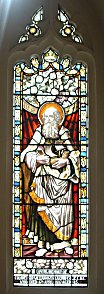Location
In the small chapel on the south side of the nave.

Window

HAS BEEN ERECTED
TO THE GLORY OF GOD
AND IN LOVING MEMORY OF
COLONEL SIR WILLIAM
OWEN LANYON CB KCMC
WHO DIED IN NEW YORK
ON THE 6TH DAY OF APRIL 1887
IN HIS 45TH YEAR
AND ALSO OF HIS WIFE
FLORENCE
WHO DIED IN LONDON
ON THE 4TH DAY OF MAY 1883
IN HER 32ND YEAR
THEY LIE IN THE SAME GRAVE
IN BROMPTON CEMETERY, LONDON
Inscription (Window)
WHO DIED 6TH APRIL 1887 AGED 45
William Owen Lanyon was born on 21 July 1842. He was the son of the civil engineer and architect Sir Charles Lanyon (1813–1889) of The Abbey, White Abbey, near Belfast, co. Antrim, and his wife, Elizabeth Helen (d. 1858), daughter of Jacob Owen of the board of works, Dublin. Lanyon was educated at Bromsgrove School, Worcestershire (1855–9) and on 21 December 1860 he was commissioned ensign by purchase in the 6th Royal Warwickshire regiment. The same year he was appointed aide-de-camp to the general commanding in the West Indies.
He purchased his lieutenancy in the 6th foot, in 1866, exchanged to the 2nd West India regiment, and in 1868 purchased a company. He was aide-de-camp and private secretary to Sir John Peter Grant, governor of Jamaica from 1868 to 1873. In 1873, and until invalided in January 1874, Lanyon served as aide-de-camp to Sir Garnet Wolseley in the Second Anglo-Asante War, suffering fever and gaining Wolseley's praise. In 1874 he was sent by the Colonial Office to the Gold Coast on a special mission connected with the abolition of slavery, for which he was in August 1875 made CMG. From September 1875 to April 1880 he was administrator of the diamond fields territory, Griqualand West.
From March 1879 Lanyon was administrator of the Transvaal under the successive high commissioners Wolseley and Sir George Colley. Lanyon assisted Sir Bartle Frere in his negotiations with the Transvaal Boers. On Wolseley's recommendation Lanyon was made KCMG in April 1880: disliking the name William, he called himself Sir Owen.
Lanyon, like Wolseley, despised the Boers, whom he considered a 'semi-civilized people'. They, in return, disliked him. As he was tall, dark, tanned, and swarthy, they believed he had African blood, was a 'West Indian bastard’, and that they were being oppressed by a ‘kaffir’. Kruger wrote in his memoirs that Lanyon was ‘absolutely unfitted for this difficult task’ (Kruger, 1.154). The new Gladstone government (April 1880) retained Lanyon in post. As Boer unrest increased he assured the Colonial Office that they were contented, and requested a substantial salary increase. Following his reports the imperial government reduced British troops in the Transvaal. In December rebel Boers declared their republic and attacked British troops (the Anglo-Transvaal War, 1880–81). Lanyon's failure in the Transvaal ruined his reputation and effectively ended his career. He was criticized in the British press and later by historians: according to C. W. de Kiewiet, Lanyon was guilty of 'stupid ignorance' of the Boers, and 'his conduct as a soldier was conceited, fatuous and shortsighted' (de Kiewiet, 273). He never again held a Colonial Office post.
Lanyon served in the 1882 Egyptian campaign as colonel on the staff and base commander at Isma'iliyyah, and also served with the Gordon relief expedition (1884–5). In 1882 he married Florence Levy of Grosvenor Street, London; she died in 1883. Lanyon died of cancer at New York, after a long and painful illness, on 6 April 1887, aged forty-four.
Lanyon became a Companion of the Order of the Bath in 1878 and a Knight Commander of the Order of St Michael and St George in 1880.
REFERENCES
Oxford Dictionary of National Biography
